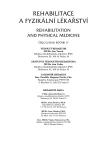Effects of Treatment with Biosynchron 500 on Motor a Non-motor Symptoms in Patients with Parkinson Disease – Results of a Randomized Study
Authors:
P. Bártová 1; D. Školoudík 1,2; J. Slonková 1
Authors‘ workplace:
Neurologická klinika FN Ostrava, vedoucí kliniky MUDr. M. Bar, Ph. D.
1; Neurologická klinika LF UP a FN, Olomouc, vedoucí kliniky prof. MUDr. P. Kaňovský, CSc.
2
Published in:
Rehabil. fyz. Lék., 17, 2010, No. 2, pp. 58-62.
Category:
Original Papers
Overview
Multifunction synchronizing biostimulator BIOSYNCHRON 500 involves three physical principles - thermotherapy, magnetotherapy, and phototherapy. All of these procedures are used in physiotherapy. The aim of the randomized study was to determine the BIOSYNCHRON 500 effects on both motoric and non-motoric symptoms of Parkinson’s disease during 2 weeks overnight therapy. There was no significant difference in changes of subjective and objective symptoms of the disease, but there was only non-significant subjective improvement in total clinical status. Prospective randomized studies with large number of Parkinson’s disease patients are needed to confirm the results of this study.
Key words:
thermotherapy, magnetotherapy, phototherapy, Parkinson’s disease
Sources
1. Athanasiou, A., Karkambounas, S., Batistatou, A. et al.: The effect of pulsed EMG fields on secondary skin wound healing: An experimental study. Bioelectromagnetics , 28, 2007, s. 362-368.
2. Berliner, M. N., Maurer, A. I.: Effect of different methods of thermotherapy on skin microcirculation. Am. J. Phys. Med. Rehabil., 83, 2004, s. 292-297.
3. Davis, S., Mirick, D. K., Chen, C., Stanczyk, F. Z.: Effects of 60-Hz magnetic field exposure on nocturnal 6-sulfatoxymelatonin, estrogens, luteinizing hormone, and follicle-stimulating hormone in healthy reproductive-age women: results of a crossover trial. Ann. Epidemiol., 16, 2006, s. 622-631.
4. Harden, R. N., Remble, T. A., Houle, T. T. et al.: Prospective, randomized, single-blind, sham treatment-controlled study of the safety and efficacy of an electromagnetic field device for the treatment of chronic low back pain: a pilot study. Pain Pract., 2007, 7, s. 248-255.
5. Höfner, K., Gonnermann, O., Grünewald, V., Kuczyk, M., Jonas, U.: Urodynamics and transurethral microwave thermotherapy. World J. Urol., 16, 1998, s. 131-137.
6. Hughes, A. J., Daniel, S. E., Kilford, L., Lees, A. J.: Accuracy of clinical diagnosis of idiopathic Parkinson@s Disease: a clinico-pathological study of 100 cases. J. Neurol. Neurosurg. Psychiatry, 55, 1992, s. 181-184.
7. Chaudhuri, K. R., Pal, S., DiMarco, A. et al.: The Parkinson’s disease sleep scale: a new instrument for assessing sleep and nocturnal disability in Parkinson’s disease. J. Neurol. Neurosurg. Psychiatry, 73, 2002, s. 629-635.
8. Jankovic, J., Tolosa, E. (eds): Parkinsonęs Disease and Movement Disorders. 5th edition. Philadelphia, William and Wilkins, 2007, s. 67-76.
9. Knotek, P.: Měření časového aspektu bolesti vizuální analogovou škálou a verbální stupnicí. Bolest, 2006, 1, s. 30-34.
10. Marinus, J., Visser, M., van Hilten, J. J., Lammers, G. J., Stiggelbout, A. M.: Assessment of sleep and sleepiness in Parkinson disease. Slep, 26, 2003, s.1049-1054.
11. Morison, W. L.: Phototherapy and photochemotehrapy: An Update. Semin Cutan Med. Surg., 18, 1999, s. 297-306.
12. Pavlů, D.: Speciální fyzioterapeutické koncepty a metody. 2. vyd., Brno, CERM, 2004.
13. Pelka, R. B., Jaenicke, C., Gruenwald, J.: Impulse magnetic-field therapy for erectile dysfunction: a double-blind, placebo-controlled study. Adv. Ther., 19, 2002, s. 53-60.
14. Pfeiffer, J., Votava, J.: Rehabilitace s využitím techniky. Praha, Avicenum, 1983, s. 128-152.
15. Pieber, K., Schuhfried, O., Fialka-Moser, V.: Pulsed electromagnetic fields (PEMF) - results in evidence based medicine. Wien Med Wochenschr, 157, 2007, s. 34-36.
16. Schott, G. d.: Pain in Parkinson s disease. Pain, 22, 1985, 4, s.407-411.
17. Tandberg, E., Larsen, J. P., Aarsland, D., Cummings, J. L.: The occurrence of depression in Parkinson’s disease. A community-based study. Arch. Neurol., 53, 1996, s. 175-179.
18. TROCK, D. H.: EMG fields and magnets. Investigational treatment for musculoskeletal disorders. Rheum. Dis. Clin. North Am., 26, 2000, s. 51-62.
19. Weintraub, D., Morales, K. H., Moberg, P. J. et al.: Antidepressant studies in Parkinson@s disease: a review and meta-analysis. Mov. Disord., 20, 2005, s. 1161-1169.
20. Woldanska-Okonska, M., Karasek, M., Czernicki, J.: The influence of chronic exposure to low frequency pulsating magnetic fields on concentrations of FSH, LH, prolactin, testosterone and estradiol in men with back pain. Neuro Endocrinol Lett, 25, 2004, s. 201-206.
21. YAMBE, T., INOUE, A., SEKINE, K. et al.: Effect of the alternative magnetic stimulation on peripheral circulation for regenerative medicine.Biomed. Pharmacother., 59, 2005, (Suppl. 1) s. S174-S176.
22. Žďárská, D., Kvapil, N.: Závěrečná zpráva o klinickém hodnocení zdravotnického prostředku. Klinické hodnocení zdravotnického prostředku pro fyzikální terapii Biosynchron 500. Praha, FN Motol, 2007.
Labels
Physiotherapist, university degree Rehabilitation Sports medicineArticle was published in
Rehabilitation & Physical Medicine

2010 Issue 2
- Hope Awakens with Early Diagnosis of Parkinson's Disease Based on Skin Odor
- Deep stimulation of the globus pallidus improved clinical symptoms in a patient with refractory parkinsonism and genetic mutation
Most read in this issue
- Hallux Valgus from the Physiotherapist Standpoint or Is Hallux Valgus Just a Hallux Deformity?
- Evaluation of Motoric Defects in Childhood
- Effects of Treatment with Biosynchron 500 on Motor a Non-motor Symptoms in Patients with Parkinson Disease – Results of a Randomized Study
- Organization of Rehabilitation with Use of ICF (International Classification of Functioning, Disability and Health WHO), Assessment of Degrees of Disability According to Qualifiers)
